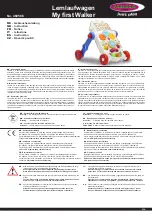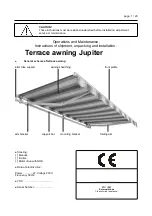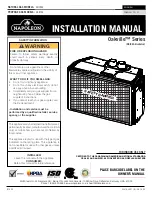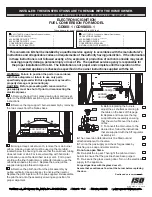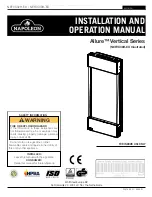
Mounting Location
• The starboard side of the hull where the propeller bla-
des are moving downward is preferred.
• The multisensor must be continuously immersed in water.
• The water flowing across the hull must be smooth with a
minimum of bubbles and turbulence (especially at high
speeds).
• The transducer beam must be unobstructed by the keel
or propeller shaft(s).
• Choose a location with a minimum deadrise angle.
• Inside the vessel, choose an accessible spot with adequte
headroom for the height of the housing, tightening the
nuts, and removing the insert. Allow a minimum of 280
mm (11”).
Hull Types
Fig. 3. Location for multisensor
near the centerline.
• Planing hull powerboats—Mount well aft, on or near
the centerline, and well inboard of the first set of lifting
strakes to insure that the multisensor is in contact with
the water at high speeds.
I/O—Mount just forward of the engine(s).
Inboard—Mount well ahead of the propeller(s) and
shaft(s).
Step-hull—Mount just ahead of the first step.
Boat capable of speeds above 25 kn (29 MPH)—
Review the installation location and operating results
of similar boats before proceeding.
• Fin keel sailboats—Mount on or as close as possible
to the centerline and forward of the fin keel 300–600
mm (1–2’).
• Full keel sailboats—Locate amidships and away
from the keel at the point of minimum deadrise.
IMPORTANT! Do not mount the multisensor in an
area of turbulence or bubbles: near water intake or
discharge openings; behind strakes, fittings or hull
irregularities; or behind eroding paint (an indication
of turbulence).
Installation
Cored fiberglass hull—Follow separate instructions ”In-
stallation in a Cored Fiberglass Hull”.
Hole Drilling
WARNING! Always wear safety goggles and a dust
mask.
1.
Drill a 3 mm or 1/8” pilot hole from inside the
hull. If there is a rib, strut or other hull irregularity near the
selected mounting location, drill from the outside.
2.
Using the appropriate size hole saw, cut a hole
from outside the hull.
Flush housing—Use a countersink tool to make a “seat”
in the hull.
3.
Sand and clean the area around the hole, inside
and outside, to ensure that the sealant will adhere proper-
ly to the hull. If there is any petroleum residue inside the
hull, remove it with either mild household detergent or a
weak solvent (alcohol) before sanding.
Metal hull—Remove all burrs with a file and sandpaper.
Bedding
Apply a 2 mm (1/16”) thick layer of marine sealant around
the lip of the housing that contacts the hull and up the
sidewall of the housing. The sealant must extend 6 mm
(1/4”) higher than the combined thickness of the hull, was-
her(s), and hull nut (see Fig. 4). This will ensure there is
sealant in the threads to seal the hull and to hold the hull
nut securely in place.
Fig. 4. Bedding and installation
Small displacement hulls
Fin keel sailboats
= Best location for multisensor
Planing hulls
Large displacement hulls
Full keel sailboats
Insert
Safety wire
Washer
Cap nut
Housing
Hull nut
Marine sealant
Hull
• Displacement hull powerboats—Locate amidships






















